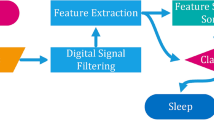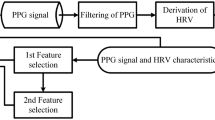Abstract
It is extremely significant to identify sleep stages accurately in the diagnosis of obstructive sleep apnea. In the study, it was aimed at determining sleep and wakefulness using a practical and applicable method. For this purpose , the signal of heart rate variability (HRV) has been derived from photoplethysmography (PPG). Feature extraction has been made from PPG and HRV signals. Afterward, the features, which will represent sleep and wakefulness in the best possible way, have been selected using F-score feature selection method. The selected features were classified with k-nearest neighbors classification algorithm and support vector machines. According to the results of the classification, the classification accuracy rate was found to be 73.36 %, sensivity 0.81, and specificity 0.77. Examining the performance of the classification, classifier kappa value was obtained as 0.59, area under an receiver operating characteristic value as 0.79, tenfold cross-validation as 77.35 %, and F-measurement value as 0.79. According to the results accomplished, it was concluded that PPG and HRV signals could be used for sleep staging process. It is a great advantage that PPG signal can be measured more practically compared to the other sleep staging signals used in the literature. Improving the systems, in which these signals will be used, will make diagnosis methods more practical.










Similar content being viewed by others
References
Linz D, Linz B, Hohl M, Böhm M (2015) Atrial arrhythmogenesis in obstructive sleep apnea: Therapeutic implications. Sleep Med Rev 26:87–94
Cock VCD, Benard-Serre N, Driss V, Granier M, Charif M, Carlander B, Desplan M, Langenier MC, Cugy D, Bayard S (2015) Supine sleep and obstructive sleep apnea syndrome in Parkinson’s disease. Sleep Med 16(12):1497–1501
Berry RB, Budhiraja R, Gottlieb DJ, Gozal D, Iber C, Kapur VK, Marcus CL, Mehra R, Parthasarathy S, Quan SF, Redline S, Strohl KP, Davidson Ward SL, Tangredi MM (2012) Rules for scoring respiratory events in sleep: update of the 2007 AASM Manual for the Scoring of Sleep and Associated Events. Deliberations of the Sleep Apnea Definitions Task Force of the American Academy of Sleep Medicine. J Clin Sleep Med (JCSM) 8(5):597–619
Borgström A, Nerfeldt P, Friberg D (2013) Questionnaire OSA-18 has poor validity compared to polysomnography in pediatric obstructive sleep apnea. Int J Pediatric Otorhinolaryngol 77(11):1864–1868
Bruyneel M, Ninane V (2014) Unattended home-based polysomnography for sleep disordered breathing: current concepts and perspectives. Sleep Med Rev 18(4):341–347
Song C, Liu K, Zhang X, Chen L, Xian X (2015) An obstructive sleep apnea detection approach using a discriminative hidden Markov model from ECG signals. IEEE Trans Bio-med Eng
Kavsaoğlu AR, Polat K, Bozkurt MR (2014) A novel feature ranking algorithm for biometric recognition with PPG signals. Comput Biol Med 49:1–14
Kavsaoğlu AR, Polat K, Muthusamy H (2015) Non-invasive prediction of hemoglobin level using machine learning techniques with the PPG signal’s characteristics features. Appl Soft Comput 37:983–991
Kim MS, Cho YC, Seo S-T, Son C-S, Kim Y-N (2012) Comparison of heart rate variability (HRV) and nasal pressure in obstructive sleep apnea (OSA) patients during sleep apnea. Measurement 45(5):993–1000
Hayet W, Slim Y (2012) Sleep–wake stages classification based on heart rate variability. In: 2012 5th international conference on biomedical engineering and informatics. IEEE, pp 996–999
Penzel T, Kantelhardt JW, Becker HF, Peter JH, Bunde A (2003) Detrended fluctuation analysis and spectral analysis of heart rate variability for sleep stage and sleep apnea identification. In: Computers in cardiology, 2003. IEEE, pp 307–310
Roche F, Sforza E, Duverney D, Borderies J-R, Pichot V, Bigaignon O, Ascher G, Barthélémy J-C (2004) Heart rate increment: an electrocardiological approach for the early detection of obstructive sleep apnoea/hypopnoea syndrome. Clin Sci (London, England: 1979) 107(1):105–110
Yilmaz B, Asyali MH, Arikan E, Yetkin S, Ozgen F (2010) Sleep stage and obstructive apneaic epoch classification using single-lead ECG. Biomed Eng Online 9(1):39
Poupard L, Mathieu M, Goldman M, Chouchou F, Roche F (2012) Multi-modal ECG Holter system for sleep-disordered breathing screening: a validation study. Sleep Breath = Schlaf & Atmung 16(3):685–693
Faust O, Acharya UR, NG EYK, Futita H (2016) A review of ECG-based diagnosis support systems for obstructive sleep apnea. J Mech Med Biol 16(01):1640004
Acharya UR, Chua EC-P, Faust O, Lim T-C, Lim LFB (2011) Automated detection of sleep apnea from electrocardiogram signals using nonlinear parameters. Physiol Meas 32(3):287–303
Dehkordi P, Garde A, Karlen W, Wensley D, Ansermino JM, Dumont GA (2014) Sleep stage classification in children using photoplethysmogram pulse rate variability. In: Computing in cardiology conference (CinC). IEEE, pp 297–300
Jezzini A, Ayache M, Elkhansa L, Al Abidin Ibrahim Z (2015) ECG classification for sleep apnea detection. In: 2015 international conference on advances in biomedical engineering (ICABME). IEEE, pp 301–304
Masa JF, Corral J, de Cos JS, Duran-Cantolla J, Cabello M, Hernández-Blasco L, Monasterio C, Alonso A, Chiner E, Aizpuru F, Vázquez-Polo F-J, Zamorano J, Montserrat JM, Garcia-Ledesma E, Pereira R, Cancelo L, Martinez A, Sacristan L, Salord N, Carrera M, Sancho-Chust JN, Negrín MA, Embid C (2013) Effectiveness of three sleep apnea management alternatives. Sleep 36(12):1799–1807
Annakkaya AN, Balbay Ö, Cahit BLGN, Erbafi M, Arbak P (2004) Outcomes of the eight-channel ambulatory recording unit in a sleep laboratory. Eur J Pulmonol 6(1):12–23
Gaurav G, Mohanasankar S, Kumar V Jagadeesh dec (2013) Apnea sensing using photoplethysmography. In: 2013 seventh international conference on sensing technology (ICST). IEEE, pp 285–288
Lazaro J, Gil E, Vergara JM, Laguna P (2012) OSAS detection in children by using PPG amplitude fluctuation decreases and pulse rate variability. Comput Cardiol 2012:185–188
Wallisch ASDP, Lusignan ME, Benayoun MD, Baker TI, Hatsopoulos NG (2014) MATLAB for neuroscientists: an introduction to scientific computing in MATLAB
Ramachandran KM, Chris P (2015) Elsevier, Tsokos. Mathematical Statistics with Applications in R
Shi P, Zhu Y, Allen J, Hu S (2009) Analysis of pulse rate variability derived from photoplethysmography with the combination of lagged Poincaré plots and spectral characteristics. Med Eng Phys 31(7):866–871
Polat K, Güneş S (2009) A new feature selection method on classification of medical datasets: Kernel F-score feature selection. Expert Syst Appl 36(7):10367–10373
Şahan S, Polat K, Kodaz H, Güneş S (2007) A new hybrid method based on fuzzy-artificial immune system and k-nn algorithm for breast cancer diagnosis. Comput Biol Med 37(3):415–423
Cortes C, Vapnik V (1995) Support-vector networks. Mach Learn 20:273–297
Mandhala VN, Sujatha V, Devi BR (2014) Scene classification using support vector machines. In: 2014 IEEE international conference on advanced communications, control and computing technologies. IEEE, pp 1807–1810
Pérez-Godoy MD, Rivera AJ, Carmona CJ, del Jesus MJ (2014) Training algorithms for radial basis function networks to tackle learning processes with imbalanced data-sets. Appl Soft Comput 25:26–39
Rasch D, Teuscher F, Guiard V (2007) How robust are tests for two independent samples? J Stat Plan Inference 137(8):2706–2720
Alpar R (2010) Applied statistic and validation—reliability. Detay Publishing, Ankara
Wang J-S, Shih G-R, Chiang W-C (2012) Sleep stage classification of sleep apnea patients using decision-tree-based support vector machines based on ECG parameters. In: Proceedings of 2012 IEEE-EMBS international conference on biomedical and health informatics. IEEE, pp 285–288
Yu S, Chen X, Wang B, Wang X (2012) Automatic sleep stage classification based on ECG and EEG features for day time short nap evaluation. In: Proceedings of the 10th world congress on intelligent control and automation. IEEE, 4974–4977
Acknowledgments
This research was supported by The Scientific and Technical Research Council of Turkey (TUBITAK) through The Research Support Programs Directorate (ARDEB) with project number of 115E657, and project name of “A New System for Diagnosing Obstructive Sleep Apnea Syndrome by Automatic Sleep Staging Using Photoplethysmography (PPG) Signals and Breathing Scoring” and by The Coordination Unit of Scientific Research Projects of Sakarya University. Produced from the doctoral thesis “Development of A New System for The Diagnosis of Sleep Staging and Sleep Apnea Syndrome” under the consultancy of the authors (Mehmet Recep Bozkurt), this study was supported by the SAU Commission of Scientific Research Projects (Project No: 2014-50-02-022). The ethics committee report numbered 16214662/050.01.04/70 from Sakarya University Deanship of Faculty of Medicine, and the data use permission numbered 94556916/904/151.5815 from T.C. Ministry of Health Turkey Public Hospitals Authority Sakarya Province General Secretariat of Association of Public Hospitals were received to perform the study.
Author information
Authors and Affiliations
Corresponding author
Rights and permissions
About this article
Cite this article
Uçar, M.K., Bozkurt, M.R., Bilgin, C. et al. Automatic sleep staging in obstructive sleep apnea patients using photoplethysmography, heart rate variability signal and machine learning techniques. Neural Comput & Applic 29, 1–16 (2018). https://doi.org/10.1007/s00521-016-2365-x
Received:
Accepted:
Published:
Issue Date:
DOI: https://doi.org/10.1007/s00521-016-2365-x




